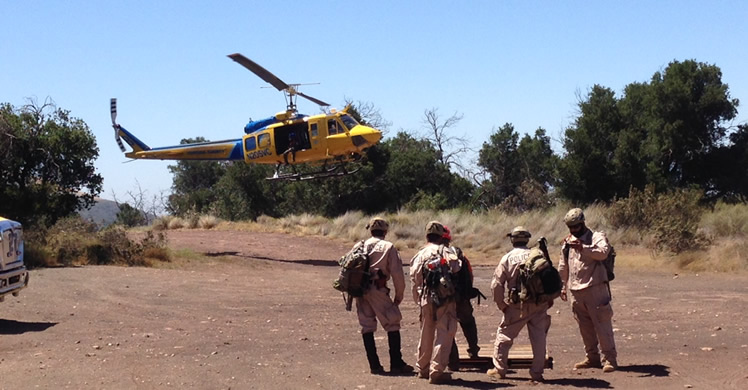ICE HSI Los Angeles Rapid Response Team trains in preparation for danger
Not everyone can ask for a ride from the United States Air Force (USAF). U.S. Immigration and Customs Enforcement (ICE) Homeland Security Investigations’ (HSI) Los Angeles Rapid Response Team (RRT) is one group that can.
When a natural or man-made disaster strikes, HSI Los Angeles RRT deploys as first responders to provide help to people in need. The team is uniquely qualified as a mobile unit.
The USAF through its Operation Patriot Hook offers highly specialized training each year on how to categorize and load emergency relief equipment onto planes efficiently and promptly. During the USAF training, the HSI Los Angeles RRT keeps their skills sharp and learns the latest science and techniques behind loading planes. With the largest, most technologically advanced fleet in the world, the USAF knows a thing or two about aircraft. The Team is also certified to separate, itemize and contain hazardous materials like ammunition, fuel and batteries to ensure safety for all those on board the aircraft.
In the case of an actual disaster or emergency and the declaration of an Emergency Support Function (ESF) 13, the Federal Emergency Management Agency (FEMA) coordinates relief efforts. FEMA will arrange and pay for the HSI RRT’s USAF ride. If the USAF is unable to provide assistance, FEMA has contracts with commercial carriers for transportation needs.
Hurricanes have served as milestones for the HSI RRT national program under the HSI Headquarters’ Emergency Management Unit (EMU). EMU oversees approximately 19 RRTs across the country.
One of the deadliest hurricanes in the history of the United States, Hurricane Katrina, in 2005, brought about the idea for Rapid Response Teams. After seeing the response of government personnel to the disaster, HSI realized that there were highly trained and capable individuals ready and willing to assist those in need. At the time, those resources were not organized, trained or equipped to be an effective asset to a national disaster response.
HSI RRT Los Angeles serves as a “jack-of-all-trades” organization. It is built to be completely self-sustaining for seven days, and sometimes longer. Commander Reynolds explained, “We go and provide help. We don’t need to be a burden. We provide our own food, fuel and security so we can focus on the people in distress.”
Recently, Hurricane Lester in Hawaii seemed like the perfect opportunity for the Team to put their USAF training to use. They were ready to be deployed to Hawaii as first responders but the tropical storm dissipated and they did not end up making the trip. Commander Reynolds explained why that was not the point, “We did not end up going, but we were ready to go.”
Many HSI RRTs have a specialization. San Diego RRT is trained to navigate tunnels and confined spaces under emergency conditions. Los Angeles RRT specializes in Search and Rescue (SAR) operations. Commander Reynolds said, “Seventeen members of our team are SAR certified technicians, level two. We focus on wilderness search and rescue, but also have the capability to search urban areas.” The Team’s primary training partner for search and rescue operations is the Los Angeles County Sheriff’s Department, Malibu Search and Rescue Team. In 2014, the Los Angeles RRT worked for three days with Ventura County SAR looking for a firefighter from Arcadia, California who went missing while hiking in a remote area near Fillmore, California. His body was located several weeks later.
In addition to search and rescue expertise, the Team also possesses a wealth of medical knowledge. There are four Emergency Medical Technicians on the team and two are ICE certified Tactical Medics. They received training from an ICE endorsed program in conjunction with Johns Hopkins University.
On Dec. 2, 2015 HSI Los Angeles RRT was requested to provide assistance to the San Bernardino Police Department in support of multiple active shooter/terrorist attacks at the Department of Developmental Services in San Bernardino, California. HSI Los Angeles RRT deployed to the scene for three days, establishing vital temporary shelters, lights and generators, staffing the mobile command center and perimeter security for the California governor during his site visit.
This year, the team worked closely with the HSI Special Response Team (SRT) as a tactical and medical response force to monitor approximately 3 miles of the annual Rose Bowl Parade route. As a national Special Event Assessment Rated event the Rose Parade and Rose Bowl football game were deemed potential soft targets for terrorist attacks. The Team’s professionalism and readiness earned them an invitation to return next year.
The HSI RRT Los Angeles is staffed completely with volunteers, the majority of whom are HSI special agents and administrative personnel for support. Los Angeles has 27 members on its team. Each person must train a minimum 96 hours per year to remain an active member though many put in more than 200 hours annually. ICE HSI allows agents to dedicate a portion of their regular work load to RRT training and serve as a collateral duty.
Commander Reynolds explained why the RRT is motivated to do difficult and dangerous work: “We take great pride in what we do. There is a great level of sacrifice to learn how to do what we do. We do it because every team member wants to help those in distress; they are ready to go into austere environments and willing to sacrifice their safety to fulfill the greater good.”





